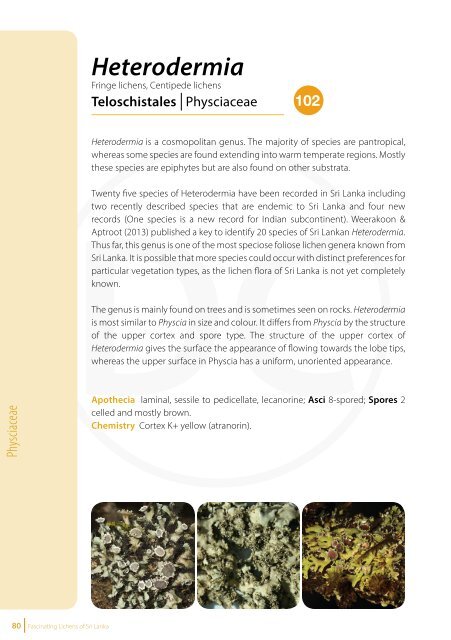You also want an ePaper? Increase the reach of your titles
YUMPU automatically turns print PDFs into web optimized ePapers that Google loves.
Heterodermia<br />
Fringe lichens, Centipede lichens<br />
Teloschistales Physciaceae<br />
102<br />
Heterodermia is a cosmopolitan genus. The majority <strong>of</strong> species are pantropical,<br />
whereas some species are found extending into warm temperate regions. Mostly<br />
these species are epiphytes but are also found on other substrata.<br />
Twenty five species <strong>of</strong> Heterodermia have been recorded in <strong>Sri</strong> <strong>Lanka</strong> including<br />
two recently described species that are endemic to <strong>Sri</strong> <strong>Lanka</strong> and four new<br />
records (One species is a new record for Indian subcontinent). Weerakoon &<br />
Aptroot (2013) published a key to identify 20 species <strong>of</strong> <strong>Sri</strong> <strong>Lanka</strong>n Heterodermia.<br />
Thus far, this genus is one <strong>of</strong> the most speciose foliose lichen genera known from<br />
<strong>Sri</strong> <strong>Lanka</strong>. It is possible that more species could occur with distinct preferences for<br />
particular vegetation types, as the lichen flora <strong>of</strong> <strong>Sri</strong> <strong>Lanka</strong> is not yet completely<br />
known.<br />
The genus is mainly found on trees and is sometimes seen on rocks. Heterodermia<br />
is most similar to Physcia in size and colour. It differs from Physcia by the structure<br />
<strong>of</strong> the upper cortex and spore type. The structure <strong>of</strong> the upper cortex <strong>of</strong><br />
Heterodermia gives the surface the appearance <strong>of</strong> flowing towards the lobe tips,<br />
whereas the upper surface in Physcia has a uniform, unoriented appearance.<br />
Heterodermia albicans<br />
SL<br />
R<br />
Fo<br />
Physciaceae<br />
Apothecia laminal, sessile to pedicellate, lecanorine; Asci 8-spored; Spores 2<br />
celled and mostly brown.<br />
Chemistry Cortex K+ yellow (atranorin).<br />
Description Foliose. The thallus is corticolous. The upper surface is greyish<br />
white. While the lobe margins are continuously sorediate, the lobe apices are<br />
not. The lower surface is rhizinate. Apothecia are not seen in <strong>Sri</strong> <strong>Lanka</strong>n material.<br />
Status Rare. This species is restricted to few localities in <strong>Sri</strong> <strong>Lanka</strong>. It is necessary<br />
to survey species in similar localities in <strong>Sri</strong> <strong>Lanka</strong>. New record for <strong>Sri</strong> <strong>Lanka</strong>.<br />
Physciaceae<br />
Habitat Corticolous. Above 1200 m, in wet upper montane forests.<br />
Locations Kalupahana- Knuckles mountain region.<br />
80 <strong>Fascinating</strong> <strong>Lichens</strong> <strong>of</strong> <strong>Sri</strong> <strong>Lanka</strong><br />
<strong>Fascinating</strong> <strong>Lichens</strong> <strong>of</strong> <strong>Sri</strong> <strong>Lanka</strong> 81















